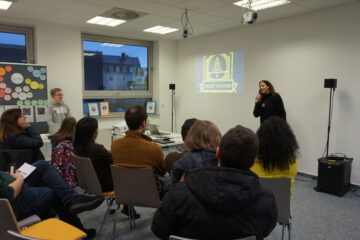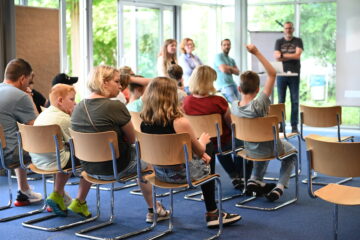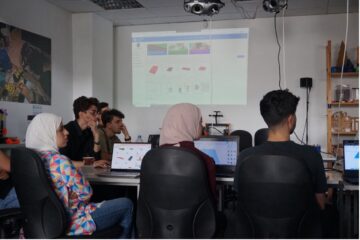As part of my master’s thesis at the Chair of Micro- and Nanoanalytics in cooperation with the Chair of Forming Technology at the University of Siegen, I developed and subsequently commissioned a bending machine for plastic forming in the scanning electron microscope.
The bending machine will be used to perform three-point bending tests to investigate the crack initiation of bent specimens in order to better utilize materials in bending forming. Forming processes are used in the manufacture of products in many areas of daily life: Cars, aircraft, ships, piping, sheet metal forming and many more.
For a detailed examination of the bending specimens during the bending test, I built the bending machine to fit the scanning electron microscope (SEM). Since there is little space available in a scanning electron microscope, the machine had to be relatively small and light – it fits on the palm of a hand. Initial bending tests in the SEM have already been carried out.

Test setup (prototype 1 and realized machine on the sample table) 
Test setup (prototype 1 and realized machine on the sample table) 
Test setup (prototype 1 and realized machine on the sample table) 
Prototype 2 – dimensions (width x depth x height): 10 x 10 x 5 cm, scale 1:1 
Real machine – dimensions (width x depth x height): 10 x 10 x 5 cm 
Prototype 2 – dimensions (width x depth x height): 10 x 10 x 5 cm, scale 1:1 
Real machine – dimensions (width x depth x height): 10 x 10 x 5 cm
Rapid Prototyping
During the design phase, I used 3D printing as a rapid prototyping process. Compared to machining processes, this method has the advantage of fast production of parts based on CAD models. The first 1:1 scale prototype was designed and 3D printed during a planning and development project, also as part of my studies.
Especially at the beginning of the project, it was important to quickly get a good idea of the real dimensions of the components to be manufactured later. Thanks to the friendly support of the Fab Lab in the person of Fabian Vitt, the required components were printed quickly and without any problems. Thanks to the friendly support of the Fab Lab in the person of Fabian Vitt, the required components were printed quickly and without any problems. In this way, all those present can get a very good picture of the shape and details of the component that will later be manufactured through the 3D printouts. This is less possible with the otherwise often used printed construction drawings. 3D prototyping can lead to new fitting ideas and facilitate the identification of necessary optimizations.
A short animation video of the bending process:
https://lmn.mb.uni-siegen.de/in-situ-em/





0 Comments